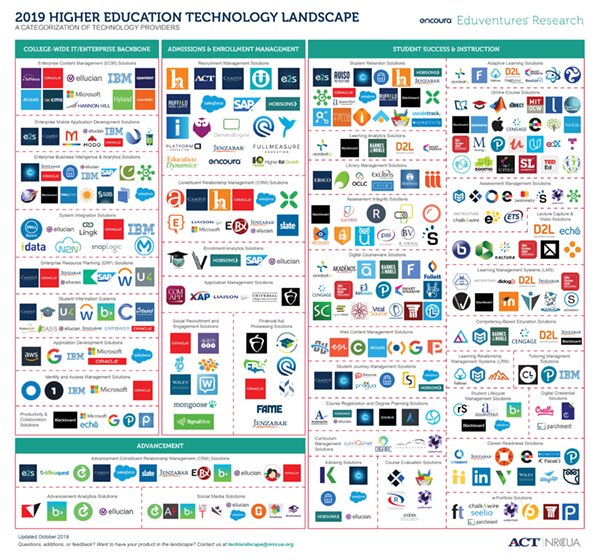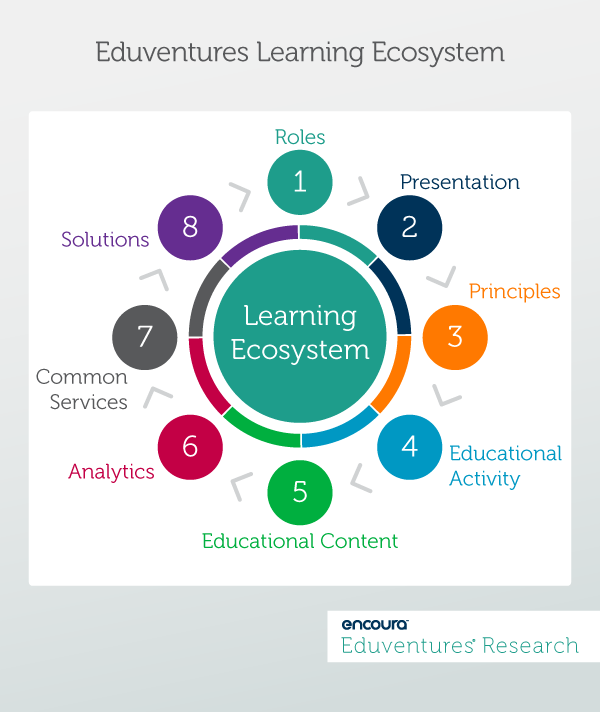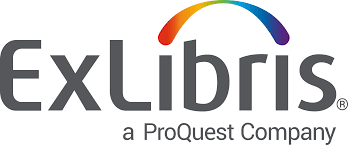Just three years ago, in 2016, the Eduventures Higher Education Technology Landscape featured 518 products across 40 segments. In the 2019 report—published this past Thursday—we feature 423 products across 42 segments, a 22% reduction. Some of these changes have to do with acquisitions and the launch of new products, but others are due to larger macro trends in how institutions are adapting to new educational models and demographic changes.
Today we’ve selected four of these companies—one from each of four new segments this year—that we think are worth watching. Read on to learn which segments we added this year, , and to download an updated version of the Landscape.
As we mentioned in a previous Wake-Up Call, the higher education technology marketplace—captured in our Higher Education Technology Landscape (Landscape)—continues to change and evolve since we first published our report in 2014 (our recent version is Figure 1 below).

One major trend we have noticed is an increased focus on developing teaching and learning ecosystems that are “future-proof” (Figure 2). These ecosystems address potential changes in areas like educational delivery, including online or in-class modalities, or better enable educational activities, such as formal and informal learning. We have also noted greater adoption of the guidelines that govern these ecosystems, such as interoperability, shareability of content, and applicability for lifelong learning.

As a result, we added new segments that enable the Landscape to reflect the range of products required to support a teaching and learning ecosystem, including course evaluation solutions, curriculum management solutions, digital credential solutions, and library management solutions. As we outline in our 2019 Higher Education Technology Landscape Report, here we will identify solutions in each newly added segment that bear considerations by institutional leaders seeking to future-proof their teaching and learning ecosystems:
Technology Landscape Vendors to Watch
eXplorance (Blue)
Our research shows that institutions are pivoting away from the traditional role of course evaluation solutions—evaluating faculty performance—to leveraging them to identify areas for course improvement, assess learning outcomes, and collect information for program review. Founded in 2003, eXplorance’s Blue solution aims to do just that: allow institutions to analyze course evaluations to gain insight into the efficacy of its educational activity and content. Likewise, Blue enables integration with other solutions (learning management systems, student information systems, etc.), which empowers institutional leaders to bring in more data to create a fuller picture of how its ecosystem performs.
currIQunet (Meta)
In a recent project with an institutional partner, we heard that the main challenge with curriculum management solutions was not cataloging curricula but establishing approval workflows and developing reports on curriculum usage and popularity. For institutional leaders faced with these challenges, we suggest that they consider currIQunet’s Meta solution. Since 1999, when it was known as Governet, currIQunet has aimed to enable institutions to gain buy-in on curriculum with their stakeholders and evaluate the performance of its educational content and determine whether there are areas that need improvement (changing of books or serials to improve student engagement, for example).
Credly (Acclaim)
Without question, there is an increasing focus on the world of digital credentials: Massachusetts Institute of Technology and eight universities are partnering on a digital credentialing initiative, and the World Wide Web Consortium (W3C) just released a data model that allows us to understand credentials technologically. Underlying each approach is the need to ensure that any credentialing solution enables validity, portability, and security. Our take is that the solution best-suited to satisfy these three requirements is Credly’s Acclaim platform, founded in 2012, as its design allows users to access and share valid and secure credentials across several devices.
ExLibris (Alma)
Our research has shown that institutional library leaders are asking how best to respond to changes in educational activity, like hands-on learning, and different content types such as digital. Library solutions have had to adapt to these changes. Our take is that ExLibris’ Alma solution is worth considering. Founded in 1999, ExLibris has developed a cloud-based solution that allows institutions to have a "one-stop-shop" for all library-related activities while also providing analytics by which librarians can measure standard key performance indicators (usage, etc.) and custom ones.
Summary
As we move beyond 2019, we will continue to monitor the market of education technology to determine whether we should include new market segments in the next iteration of the Landscape. Emerging technologies, such as the Internet of Things (IoT) and blockchain, for example, have attracted a great deal of recent buzz and merit watching.
Likewise, we will closely track how certain technologies—such as student information systems in the College-Wide IT Enterprise/Backbone category, and constituent relationship management solutions in the Enrollment Management category—continue to evolve. We expect these and possibly other technology segments may extend beyond their origins to enter other technology categories, such as Student Success & Instruction.
Thursday, October 24, 2019 at 2PM ET/1PM CT
- How do prospective adult learners make decisions regarding their educational futures?
- How can institutions and service providers better understand and anticipate the behaviors of prospective adult learners?





